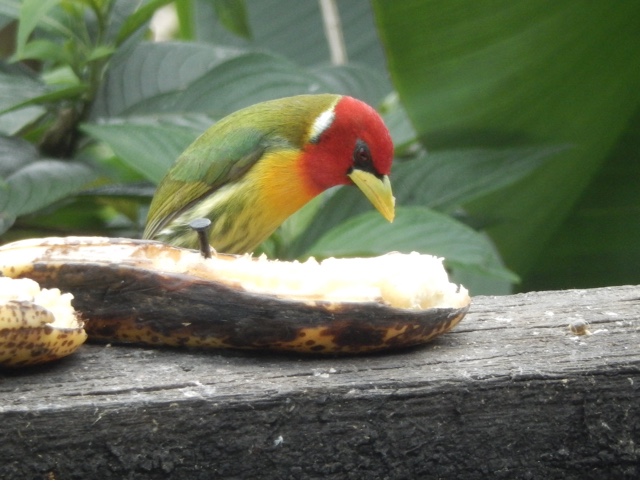March 24, Friday - Today was a very early morning - up at 5:20 am, so we could travel to Tortuguero, on the Caribbean side of Costa Rica. We rode for 2 hours across the continental divide and through rain forests before stopping for breakfast. Then we rode for another hour plus to the end of the road at a river dock, caught a river boat to a lodge across a canal from Tortugero. We are now in one of the main centers for “eco-tourism” in Costa Rica. The black sand beach of about 20 miles is the most important breeding ground for green sea turtles and is also used by four other turtle species.
Our travel today was punctuated with a number of interesting sightings. The breakfast stop offered a chance to see a tree representing one of the largest species in Costa Rica, the kapok. In addition, we saw a small bright red poison dart tree frog and both types of sloths, the brownish 2 toed and the greenish 3 toed.
We passed by numerous cattle farms and banana plantations, getting a lesson on how bananas are grown and harvested - more complicated than you might imagine given the price for a “hand” of bananas in the grocery store. We spotted numerous birds and an iguana on a fence post while bumping along an unimproved, dirt road leading to the dock. This is one way that number of tourists is managed for this ecological-sensitive area. We also stopped at a cashew tree and sampled the fruit that grows below the nut.
Once on the river boat, a unique design with a flat bottom that carries 25 to 30 people, we saw kingfishers, two Macaws, other lesser birds, a motionless crocodile and a family of spider monkeys.
We arrived at Pachira Lodge around 12:30, got our room assignments, and collected our luggage that came with us on the river boat. We then lunched - rice and beans is served at nearly every meal. After lunch, we ferried over to the town, first to the Sea Turtle Conservancy for a video on sea turtle biology, etc., a walk along the famous beach, and a spin through the town of Tortuguero. It has no streets (and no vehicles except a few quad bikes) but lots of tourists walking the alley and the main sidewalk in town. The town got its first public telephone in 1972, its first boat service in 1975 and its first electrical generation in 1981.
The lodge is quite nice, with a swimming pool, a bar and large dining room, a spa. We learned later that it is one of about 13 eco-based lodges that were built as a result of one man’s advocacy to save the sea turtles - a Floridian named Archie Carr. Over several years in the 1950’s he convinced the Costa Rican government to create a national park, thereby ending logging and effectively eliminating all employment for the town. Most people moved away but after about 15-20 years, eco-tourism developed to the point that the population is growing again. The rusting hulks of the logging companies’ machinery still sits in the middle of town. One more historical note, the town originally developed because it provided an abundant source of fresh meat and eggs; consequently Carr had to also convince the citizens to stop eating turtles and to start conserving them.
In town and at the lodge we spotted a few more birds.
And, we tried coconut water.
After we got back to the lodge, Betsy and I tried out the pool, which felt good. The weather is mostly overcast ,comfortably warm, with high humidity but no rain. It would have been perfect if the sun was out. This side of Costa Rica averages 26 feet of precipitation; the Pacific side has only a foot or two of annual rainfall - so much for getting away for rainy Portland.
We had a lecture from a local man, learning more about how the area was initially settled, and the other historical events that have shaped it. He was the third generation of an original settler who immigrated from Jamaica.
The day ended with dinner and an early night.



















































